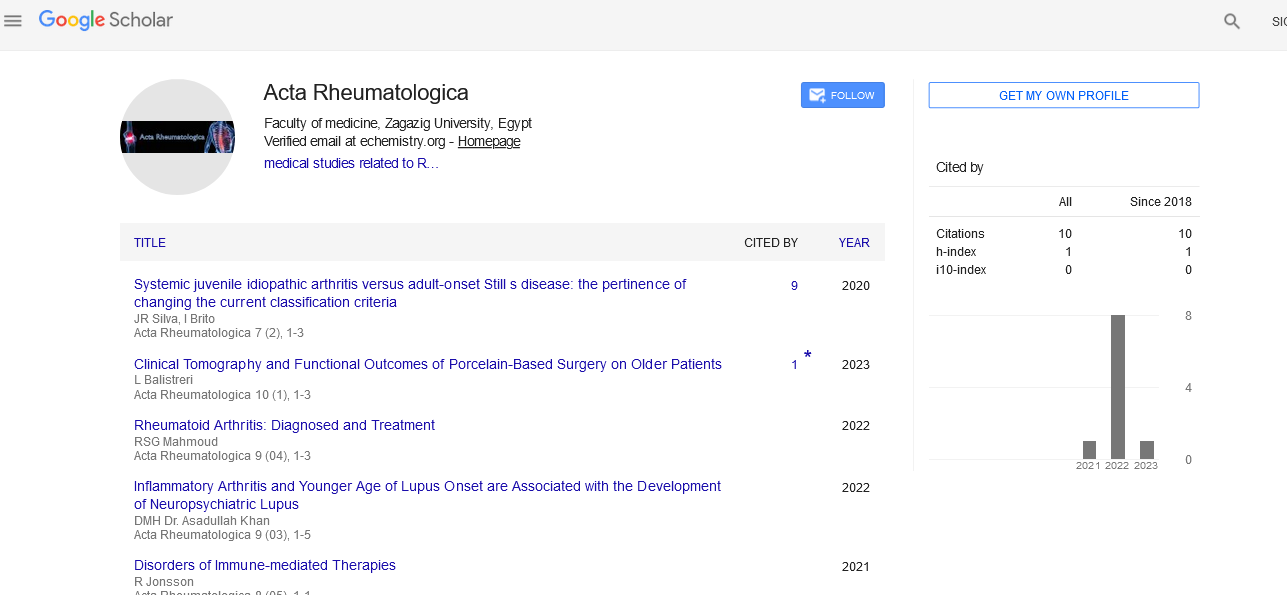Perspective - (2024) Volume 11, Issue 2
Deciphering Polymyalgia Rheumatica: Unveiling the Mysteries of a Complex Autoimmune Disorder
Michael H. Weisman*
Department of Rheumatology, Nanjing Medical University, Massachusetts, USA
*Correspondence:
Michael H. Weisman, Department of Rheumatology, Nanjing Medical University, Massachusetts,
USA,
Email:
Received: 02-Mar-2024, Manuscript No. IPAR-24-14674;
Editor assigned: 05-Mar-2024, Pre QC No. IPAR-24-14674 (PQ);
Reviewed: 20-Mar-2024, QC No. IPAR-24-14674;
Revised: 28-Mar-2024, Manuscript No. IPAR-24-14674 (R);
Published:
04-Apr-2024
Introduction
Polymyalgia Rheumatica (PMR) stands as a perplexing
autoimmune disorder that predominantly affects older adults,
causing widespread musculoskeletal pain, stiffness, and fatigue.
Despite its prevalence, PMR often presents diagnostic challenges
due to its nonspecific symptoms and overlapping features with
other rheumatic conditions. In this comprehensive article, we
embark on a journey through the intricate landscape of PMR,
exploring its etiology, clinical manifestations, diagnostic criteria,
treatment modalities, and the latest advancements in
understanding and managing this enigmatic disorder.
Description
The pathophysiology of polymyalgia rheumatic:
Unraveling the immune-mediated cascade
While the exact cause of PMR remains elusive, current
evidence suggests that it involves a dysregulated immune
response, leading to inflammation of the synovial tissue,
periarticular structures, and blood vessels. Genetic
predisposition, environmental triggers, and immunological
factors are thought to play a role in the development of PMR.
The inflammatory cascade in PMR is characterized by elevated
levels of proinflammatory cytokines, such as Interleukin-6 (IL-6)
and Tumor Necrosis Factor-alpha (TNF-alpha), which contribute
to the characteristic symptoms of pain, stiffness, and systemic
inflammation.
Clinical manifestations: Decoding the symptoms of
polymyalgia rheumatica
The hallmark symptoms of PMR include bilateral shoulder and
hip pain, stiffness, and limited range of motion, which typically
worsen in the morning or after periods of inactivity. Patients
may also experience systemic symptoms such as fatigue,
malaise, anorexia, and unintentional weight loss. Physical
examination may reveal tenderness, swelling, and restricted
movement of the affected joints, along with signs of systemic
inflammation such as fever and elevated acute-phase reactants.
Diagnostic challenges: avigating the road to diagnosis
Diagnosing PMR can be challenging, as its symptoms overlap
with those of other rheumatic conditions such as rheumatoid
arthritis, osteoarthritis, and fibromyalgia. The American College
of Rheumatology (ACR) has established classification criteria for
PMR, which include age over 50 years, bilateral shoulder pain,
morning stiffness lasting more than 45 minutes, elevated
Erythrocyte Sedimentation Rate (ESR) or C-Reactive Protein
(CRP) levels, and rapid response to low-dose corticosteroids.
However, these criteria are not specific to PMR and must be
interpreted in the context of the patient's clinical presentation
and laboratory findings.
Treatment modalities: Managing polymyalgia
rheumatica
The primary treatment for PMR involves the use of
corticosteroids, such as prednisone or prednisolone, which are
highly effective in suppressing inflammation and relieving
symptoms. The initial dose of corticosteroids is typically started
at 10-20 mg/day and gradually tapered over several months to
maintain disease remission while minimizing the risk of adverse
effects. Nonsteroidal Anti-Inflammatory Drugs (NSAIDs) may be
used as adjunctive therapy for symptomatic relief of pain and
inflammation, although they are not a substitute for
corticosteroids in the treatment of PMR.
Long-term management and prognosis
The long-term management of PMR focuses on achieving and
maintaining disease remission while minimizing the risk of
corticosteroid-related complications. Regular monitoring of
disease activity, symptoms, and laboratory parameters is
essential to guide treatment decisions and adjust corticosteroid
dosing as needed. Lifestyle modifications, including regular
exercise, balanced nutrition, and smoking cessation, can help
improve overall health and reduce the risk of cardiovascular
complications associated with PMR and its treatment.
Research advances and future directions
Despite significant progress in understanding the
pathophysiology and treatment of PMR, many questions remain unanswered, highlighting the need for further research and
clinical trials. Emerging therapies, such as biologic agents
targeting specific cytokines or immune pathways, hold promise
for improving treatment outcomes and reducing the reliance on
corticosteroids in PMR management. Genetic studies, biomarker
research, and advanced imaging techniques may provide new
insights into the underlying mechanisms of PMR and help
identify novel therapeutic targets for intervention.
Conclusion
Polymyalgia Rheumatica poses significant challenges for
patients and healthcare providers alike, but with early
recognition, prompt diagnosis, and appropriate treatment, the
majority of individuals with PMR can achieve remission and lead
fulfilling lives. By raising awareness of the signs and symptoms of
PMR, promoting timely evaluation and diagnosis, and providing
comprehensive, patient-centered care, healthcare professionals
can help empower patients to manage their condition effectively
and optimize their quality of life. Through ongoing research and
collaboration, we can continue to advance our understanding of
PMR and develop innovative strategies to improve outcomes for
affected individuals.
Citation: Weisman MH (2024) Deciphering Polymyalgia Rheumatica: Unveiling the Mysteries of a Complex Autoimmune Disorder. Acta Rheuma Vol:11 No:2





